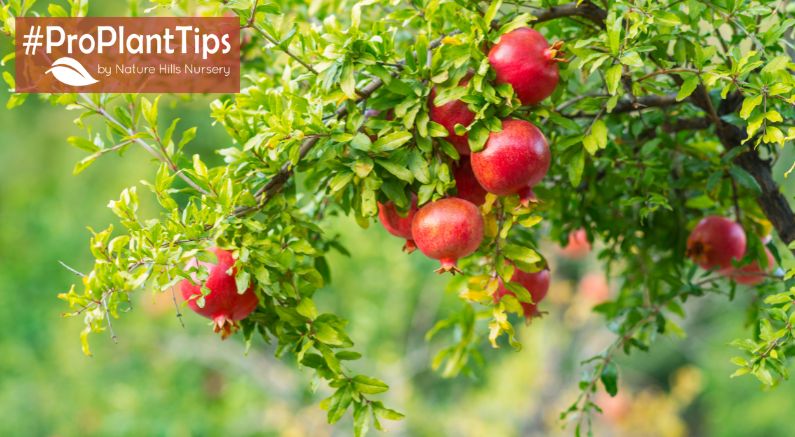
Juicy, jewel-like nuggets nestled inside a tough, leathery exterior, the Pomegranate tree (Punica granatum) and its antioxidant-rich fruit brighten both your garden and your diet! With bold red, orange, or yellow flowers and fine-textured foliage, Pomegranates are ornamental flowering and fruiting trees that enliven any edible landscape while delivering nutritious harvests.
If you live in a warmer climate and want a drought-tolerant fruit tree that combines ornamental beauty with incredibly healthful fruit, explore Nature Hills’ wide selection of Pomegranate tree varieties today.
Origins of the Pomegranate Tree
Pomegranate, meaning “seeded apple” in Latin, is as beautiful as it is beneficial. Growing your own at home not only saves you from high grocery store prices but also rewards you with abundant, fresh harvests!
Pomegranate trees are fast-growing fruit trees that produce highly prized fruit, often ripening around the holidays and given as cherished gifts. The vibrant arils hidden inside the blushed, leathery skin have been enjoyed for centuries as a heart-healthy, diet-conscious superfruit.
Pomegranates are one of the oldest cultivated fruits, beloved since ancient Mediterranean times for their exotic beauty and sweet-tart flavor. They spread across the Middle East, India, and arid regions of Southeast Asia and Northern Africa before making their way into Europe through Spain. Though England valued the fruit, its colder climate prevented successful production. Early American colonists tried growing Pomegranates, with lasting success in the warm southern colonies. Spanish settlers introduced the tree to California in 1769, where it still thrives.
Nutritional benefits:

- Low in saturated fat, cholesterol, and sodium
- High in vitamin C, calcium, iron, folate, and dietary fiber
- Rich in antioxidants that help protect blood lipids from oxidation
Pomegranate Tree Care
Pomegranates flourish in USDA zones 7-10, but gardeners in cooler climates can grow them in large containers. Simply move patio Pomegranate trees indoors to a sunny window, sunroom, or greenhouse during winter.
Easy-care and low-maintenance, these trees are disease-resistant, self-fruitful, and adaptable.
Care checklist:
- Full sun
- Moderate moisture & fertility
- Loves arborist mulch
- Prune late winter or early spring
- Plant in well-drained, average to organically rich soil
- Requires ~150-300 chill hours
- Drought-tolerant once established
Pomegranate Sun & Soil Requirements
Pomegranates tolerate many soil types but perform best in well-drained soil with full sun exposure. For best flowering and fruit set, give them at least six hours of direct light daily.
Pomegranate Tree Watering Needs
While drought-tolerant once established, young Pomegranate trees require consistent watering to set strong roots. Uneven watering can cause fruit splitting, so aim for steady moisture. Apply a three-inch layer of arborist mulch around the root zone, keeping it away from the trunk. Feed with organic fertilizer for fruiting plants according to label directions.
Container-grown Pomegranates need year-round attention. During dormancy, water sparingly, about once a month, and ensure rapid drainage.
Pruning Pomegranate Trees
Prune before new growth emerges in late winter or early spring to shape the tree, open the canopy, and remove weak, crossing, or diseased branches. Some varieties sucker freely, and you can let them form a multi-stemmed hedge for privacy or remove suckers to maintain a single trunk. You can also prune to control their size for smaller yards.
Fertility
Feed Pomegranate trees in spring with a slow-release, preferably organic fertilizer for fruit trees to encourage strong growth and better yields. If not slow-release, reapply 2–3 times during the growing season.
Thinning
For larger, healthier fruit and stronger limbs, thin clusters while the fruit is still small. Remove smaller side fruits, leaving the biggest and healthiest to mature.
Knowing When to Harvest Pomegranates

Timing is everything with Pomegranates. Once picked, they do not continue to ripen off the tree, so it is essential to harvest only when fully mature.
Signs your Pomegranates are ready to harvest:
- Skin changes from shiny to slightly matte in appearance
- Rich, deep color develops depending on variety (red, pink, or orange-brown)
- Fruit shape becomes slightly angular or hexagonal as the arils inside swell
- A metallic sound is heard when tapped gently
- Fruit feels heavy for its size, indicating juiciness
Pomegranate fruits ripen from late summer into winter, signaled by a shift from round to subtly hexagonal, depending on your growing zone and variety. Most have ruby-red arils, though varieties like Gissarskii Rozovyi are pale and grapefruit-like.
Use sharp pruning shears to cut the stem just above the fruit rather than pulling it to avoid damaging the branch. Handle fruit gently to prevent bruising.
The leathery skin can be red, green, orange, brown, or pink, often with a decorative crown at the blossom end. Inside, the juicy seeds burst with sweet-tart citrus flavor and are used fresh, in juices, jellies, wines, and salads. They also store well, up to seven months under optimal conditions, often becoming juicier over time.
Check out Nature Hills Nursery’s YouTube Channel to cut open your Pomegranate fruit and not make a mess!
Three Seasons of Color
Pomegranates deliver ornamental appeal from spring to fall:
- Spring to summer: trumpet-shaped blooms attract pollinators
- Growing season: dark green glossy foliage
- Fall: brilliant yellow leaves and large red fruit
In tropical zones, Pomegranates may remain evergreen. In cooler areas, they are deciduous with twisted, sculptural bark in winter!
Fruitful, Healthful Pomegranate Trees

From their centuries-old history to their three-season beauty, Pomegranate trees bring ornamental charm and antioxidant-rich harvests to your garden. With the right care, sun, and water, these resilient, drought-tolerant fruit trees will reward you year after year with vibrant blooms, glossy foliage, and jewel-like seeds bursting with sweet-tart flavor.
Knowing exactly when to harvest ensures every fruit is at its peak for taste, nutrition, and storage life. Whether you grow a stately tree in the landscape or keep a patio variety in a container, Pomegranates offer beauty, flavor, and tradition in every bite!
Happy Planting!


